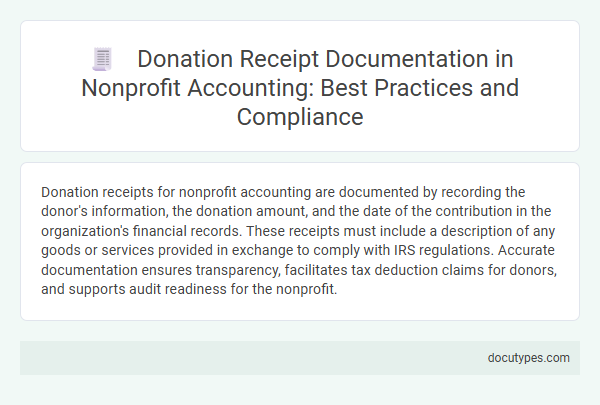Donation receipts for nonprofit accounting are documented by recording the donor's information, the donation amount, and the date of the contribution in the organization's financial records. These receipts must include a description of any goods or services provided in exchange to comply with IRS regulations. Accurate documentation ensures transparency, facilitates tax deduction claims for donors, and supports audit readiness for the nonprofit.
Introduction to Donation Receipt Documentation
Donation receipts serve as essential records in nonprofit accounting to verify contributions and ensure proper financial tracking. Understanding how these receipts are documented helps maintain transparency and compliance with regulatory standards.
- Receipt Issuance - Each donation receipt must include the donor's name, donation amount, date, and the nonprofit's information for accurate record keeping.
- Record Maintenance - Nonprofits retain copies of all donation receipts to support audit trails and financial reporting requirements.
- Legal Compliance - Proper documentation of donation receipts ensures adherence to IRS guidelines and eligibility for donor tax deductions.
Importance of Accurate Receipt Management
Donation receipts serve as critical documentation in nonprofit accounting, providing verification of charitable contributions. Accurate receipt management ensures compliance with IRS regulations and facilitates transparent financial reporting.
Properly documented receipts help nonprofits maintain donor trust and streamline audit processes. Failure to manage receipts accurately can result in legal penalties and loss of tax-exempt status.
Key Elements Required on Donation Receipts
Donation receipts for nonprofit accounting include essential details such as the donor's name, the date of the donation, and the amount or description of the donated items. These key elements ensure accurate record-keeping and compliance with tax regulations. Your receipt must also include the nonprofit's name and a statement confirming whether any goods or services were provided in exchange for the donation.
IRS and Legal Compliance Standards
Donation receipts serve as critical proof for tax deductions and nonprofit accounting accuracy. Accurate documentation ensures compliance with IRS regulations and legal standards.
Receipts must include the nonprofit's name, date of donation, amount or description of the donated item, and a statement of whether any goods or services were provided in exchange. The IRS requires receipts for donations over $250 to be acknowledged in writing. Your nonprofit must retain these records for at least three years to support audits and maintain transparency.
Digital vs. Paper Receipt Systems
Donation receipts play a critical role in nonprofit accounting by providing proof of contributions for tax and audit purposes. The choice between digital and paper receipt systems impacts accuracy, efficiency, and record-keeping.
- Digital receipt systems improve accuracy - Automated data entry reduces human errors and ensures consistent transaction records.
- Paper receipts offer tangible proof - Physical copies satisfy traditional donor preferences and legal requirements in some jurisdictions.
- Digital systems enable quick retrieval - Electronic storage allows nonprofits to access and share receipts instantly during audits or reporting.
Nonprofits benefit from evaluating their operational needs to decide between digital or paper receipt documentation for optimal fundraising transparency.
Procedures for Issuing Acknowledgment Letters
Donation receipts are essential for nonprofit accounting and must be documented accurately to ensure compliance with tax regulations. The procedures for issuing acknowledgment letters involve verifying donor information and recording the donation details in the organization's financial system.
The acknowledgment letter should include the donor's name, donation amount, date, and a statement confirming whether any goods or services were provided in exchange. You must send this letter promptly to enable donors to claim their tax deductions properly.
Recordkeeping Best Practices for Nonprofits
| Aspect | Details |
|---|---|
| Definition of Donation Receipts | Donation receipts are official documents provided by nonprofits to donors, confirming the contribution amount and enabling tax deductions. |
| Purpose in Nonprofit Accounting | Receipts serve as proof of donation for both donors and organizations, supporting accurate financial reporting and regulatory compliance. |
| Required Information on Receipts | Organization name, donor name, donation amount, date, description of donated items (if applicable), and statement regarding tax deductibility. |
| Recordkeeping Best Practices | Maintain digital and physical copies of all receipts, organize by date or donor, use accounting software to track donations, and regularly back up data. |
| Retention Period | IRS recommends retaining donation receipts and related documentation for at least 3 to 7 years for audit purposes. |
| Verification Methods | Cross-check donation receipts against bank statements, donor lists, and accounting records to ensure accuracy and prevent discrepancies. |
| Automation Tools | Utilize nonprofit accounting software with integrated receipt generation and storage functions to enhance recordkeeping efficiency. |
| Benefits of Proper Documentation | Ensures donor trust, supports tax compliance, aids in financial audits, and improves transparency in nonprofit operations. |
Managing Receipts for In-Kind Donations
How are donation receipts documented for nonprofit accounting, especially for in-kind donations?
Nonprofit organizations document donation receipts for in-kind donations by creating detailed records that describe the donated items, their fair market value, and the donor's information. Proper documentation ensures compliance with IRS regulations and supports accurate financial reporting and donor acknowledgment.
Common Mistakes and How to Avoid Them
Donation receipts are essential for accurate nonprofit accounting and tax compliance. Proper documentation ensures transparency and donor trust while avoiding regulatory issues.
- Incomplete Donor Information - Missing donor details can invalidate the receipt and complicate record-keeping.
- Lack of Acknowledgment for Non-Cash Donations - Failure to specify the fair market value of goods leads to inaccurate tax reporting.
- Omitting Receipt Dates - Not including the donation date impairs chronological tracking and audit readiness.
How Are Donation Receipts Documented for Nonprofit Accounting? Infographic

